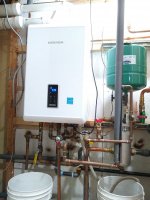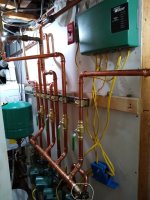Hope
New Member
I have a Navien NCB-240E combi boiler for DHW and heating (baseboard+radiators) with 4 zones. I have had issues in the past with pressure dropping and boiler stopped working and giving error code E351. Majority of the time It’s fixed by draining the radiators on the second floor (sometimes I also have to up the pressure by using the manual feeder – marked by a red arrow in the first picture).
For the past week and a half, boiler has been giving problems and shutting off with error E-351. When this happens, I bleed air out of the radiators on the second floor, press reset button on the boiler and it turns on again and starts to work fine until another Error E-351 (sometimes on the same day or a day later) shuts the boiler off.
I suspected there is air in my system and I am not able to bleed it effectively due to lack of knowledge. Did some research and hooked up a hose with the drain, shut the boiler, and shut off each zone valve and drain water by hooking up a hose to the valve marked with white circle in second picture. This didn’t work and boiler displayed ‘AIR’ sign. So I bled air from two radiators from second floor. One of the radiator didn’t discharge water after the air was bled. (
Would like to point out that, one of the radiators on the second floor, bleeds air for the first few seconds but water never comes out of it. This is the radiator which has been turning hot the last and taking the most time to heat up. ) SO I manually fed the boiler more pressure and then bled the same radiator until it had water discharging. This was done with boiler on and all zones asking for heat.
I can tell I still have air in my system and boiler will shut off in a day or so and give E 351 error.
Can someone tell me whats going on? How to effectively bleed the air out of it?
Thanks in advance.
For the past week and a half, boiler has been giving problems and shutting off with error E-351. When this happens, I bleed air out of the radiators on the second floor, press reset button on the boiler and it turns on again and starts to work fine until another Error E-351 (sometimes on the same day or a day later) shuts the boiler off.
I suspected there is air in my system and I am not able to bleed it effectively due to lack of knowledge. Did some research and hooked up a hose with the drain, shut the boiler, and shut off each zone valve and drain water by hooking up a hose to the valve marked with white circle in second picture. This didn’t work and boiler displayed ‘AIR’ sign. So I bled air from two radiators from second floor. One of the radiator didn’t discharge water after the air was bled. (
Would like to point out that, one of the radiators on the second floor, bleeds air for the first few seconds but water never comes out of it. This is the radiator which has been turning hot the last and taking the most time to heat up. ) SO I manually fed the boiler more pressure and then bled the same radiator until it had water discharging. This was done with boiler on and all zones asking for heat.
I can tell I still have air in my system and boiler will shut off in a day or so and give E 351 error.
Can someone tell me whats going on? How to effectively bleed the air out of it?
Thanks in advance.


